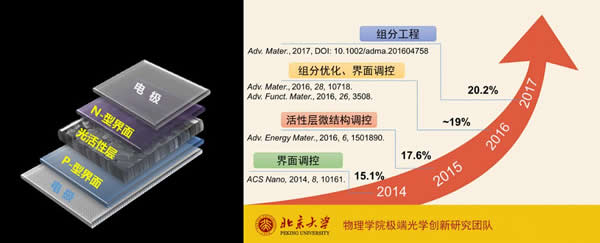
Recently, Advanced Materials published the latest progress in perovskite solar cell research by the “Extreme Optics Innovation Research Team†of the School of Physics of Peking University. The research team obtained a photoelectric conversion efficiency of more than 20% perovskite solar cells based on lead acetate precursor system, further demonstrating the development prospects of trans-perovskite solar cells.
With the increasing environmental problems, solar energy has attracted widespread attention from the scientific research community and industry due to its clean and renewable advantages. Among them, efficient and economical photovoltaic technology has also become one of the hot topics in current academic research and industrial development. In recent years, a new type of photovoltaic technology, perovskite solar cells, has entered the field of people's vision with its easy preparation, low cost, and high efficiency, and has become the new darling of new photovoltaic technologies. In just seven years, the photovoltaic conversion efficiency of perovskite solar cells has grown by leaps and bounds, from the initial 3.8% to more than 22% now, showing great advantages and potential.
Perovskite solar cells are divided into two structures: formal (nip) and trans (pin). Conventional formal devices usually require a dense or mesoporous oxide as an electron transport layer, the preparation process thereof is relatively complicated, and the compatibility with the flexible substrate is not good. In contrast, trans-structured devices have attracted more and more attention due to their advantages such as simple preparation process, low-temperature film formation, and no obvious hysteresis effect, but their photoelectric conversion efficiency is still somewhat insufficient.
In response to the problem of low efficiency of trans-structured perovskite solar cell devices, researcher Zhu Rui and academician Gong Qihuang from the "Extreme Optical Innovation Research Team" of Peking University, etc., from the perovskite film morphology control, interface control and composition optimization We have conducted a comprehensive and systematic study from an equal angle and achieved a series of innovative results in the past two years. They used a lead acetate precursor system and applied trace amounts of bromomethylamine as an additive to the perovskite precursor solution. This strategy can effectively improve the surface morphology of the perovskite film, and significantly improve its optical and electrical properties. Finally, the photoelectric conversion efficiency of trans-plane perovskite solar cells based on lead acetate precursors increased significantly from 14.26% to 18.32%. The results were published on Advanced Functional Materials and were selected as the inside pages of the back cover. The number of visits for two consecutive months after the publication of the paper was ranked in the top five of the journal, and it was also one of the most visited articles in the journal in 2016 (Adv. Funct. Mater., 2016, 26, 3508, Ph.D. students Zhao Lijun and Luo Yingying. co-author). Later, with the help of interface control, they proposed the concept of "charge carrier balance" for the first time in the field of perovskite solar cells, and systematically studied and realized charge carrier balance in trans-perovskite solar cell devices. The photoelectric conversion efficiency of trans-perovskite solar cells was further increased to close to 19%, and the results were published in Advanced Materials (Adv. Mater., 2016, 28, 10718, PhD students Chen Ke, Hu Qin, and Liu Tangyi as common First author). Afterwards, the team further adopted the dual-source precursor solution method. The introduction of "formamidine" organic cations in the system extends the absorption spectrum to the near-infrared region, and combines the optimization of the hole transport layer to ensure effective charge transfer and collection. At the same time, the open-circuit voltage of the device is increased, and the photoelectric conversion efficiency is eventually increased to more than 20%. This result, published in Advanced Materials, is the highest reported performance of a perovskite solar cell based on a lead acetate precursor system (Adv. Mater., 2017, DOI: 10.1002/adma.201604758, Ph.D. students Rodney Ying and Zhao Lijun as the first Author). In addition, they also wrote a review article on trans-structured perovskite solar cells, published in Advanced Energy Materials, systematically summarized the development status of trans-perovskite solar cells, and looked forward to the future prospects. (Adv. Energy Mater., 2016, 6, 1600457, Ph.D. Liu Tangyi as the first author).
The series of research work was supported by the National Natural Science Foundation of China, the Ministry of Science and Technology, the State Key Laboratory of Artificial Microstructure and Mesoscopic Physics of Peking University, the Collaborative Innovation Center for Extreme Optics, the 2011 Plan of the Collaborative Innovation Center for Quantum and Physical Sciences, and the Youth Millennium. "People plan" and other units such as the Lawrence Berkeley National Laboratory (LBNL).
Automatic Air Hose Reel,Auto Rewind Air Hose Reel,Self Retracting Air Hose Reel,Air Compressor Retractable Hose Reel
NINGBO QIKAI ENVIRONMENTAL TECHNOLOGY CO.,LTD , https://www.hosereelqikai.com